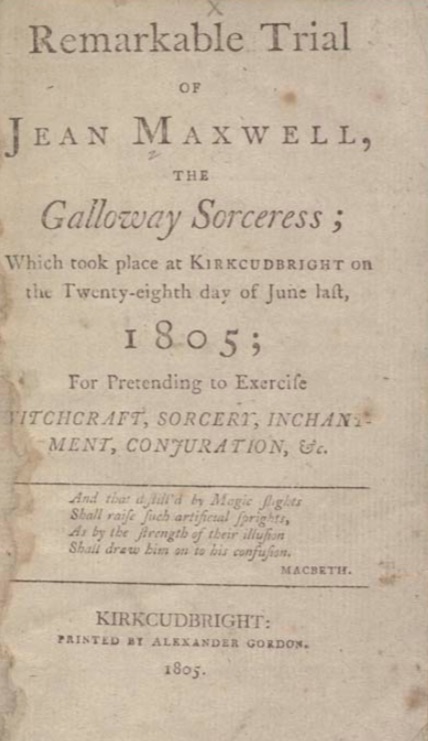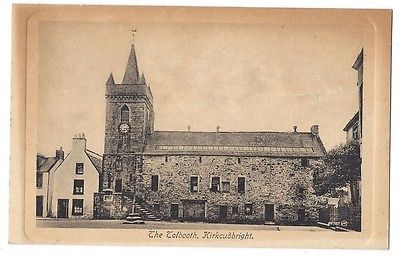Jean Maxwell, also known as the Galloway Sorceress, was a Scottish cunning woman convicted of pretending to exercise witchcraft. She was tried in Kirkcudbright in June 1805, found guilty, and sentenced to be imprisoned in the town tolbooth for a year – the maximum term permitted under the Witchcraft Act 1735Sometimes dated 1736, an Act of Parliament that repealed the statutes concerning witchcraft throughout Great Britain, including Scotland. – and to be taken to the market place every three months to be put into the jugsMetal collar formerly used as an instrument of punishment in Scotland.Metal collar formerly used as an instrument of punishment in Scotland., or pillory, for an hour.
The events that led to Jean Maxwell’s conviction took place over several weeks on a farm at Little Cocklick, where she had subjected a domestic servant, Jean Davidson, to extortion and claimed to be able to tell her fortune. Coerced into stealing clothing and meat from her employer, Davidson was also informed by Maxwell that the Devil would tear her into little pieces if she revealed details of their transactions to anyone else.
Eventually the vulnerable servant did confide in the farmer’s wife. Jean was taken into custody and charged under section four of the 1735 Witchcraft Act, one of the first in Scotland to be recorded as prosecuted under that statute. The case drew attention from legal professionals and the general public; a pamphlet published in 1805 reproduced the details and, according to a modern-day historian, was a bestseller.
Background
Francis Scott lived on a farm at Little Cocklick in the parish of Urr with his wife and their twenty-five-year-old domestic servant, Jean Davidson. The servant regularly attended church services and had been raised as a Christian.[1] Hugh Rafferton, Davidson’s boyfriend, had also been employed as a servant on the farm.[2]
Jean Maxwell visited the farm on several occasions between November 1804 and January 1805, accompanied by her eight or nine-year-old son and sometimes stayed overnight; she helped to repair sacking while her son winnowed corn.[3]
Events
Davidson stated that Jean had stayed overnight at the farm in Little Cocklick when the farmer had been tardy in returning from Dumfries. At breakfast the following morning she offered to predict Davidson’s fortune by reading tea leaves at the bottom of her cup. She intimated the outlook for Davidson was not good, adding that her boyfriend Rafferton was deceptive. Jean remained at the farmhouse all day and, after the rest of the household had gone to bed, she continued her conversation about fortune telling with Davidson. Despite being unable to read, Jean professed to be an Oxford scholar,[2] claiming she had learned her craft from a book about magic that she had inherited from her cousin.[4]
At other times Jean claimed that Davidson would become pregnant by Rafferton out of wedlock, but that she could help prevent it by using her magical skills.[5] Despite her confidence that she was not pregnant, Davidson did not know if that would continue to be the case.[6] The sorceress also informed her victim that Rafferton would lose his sanity if any proposal of marriage she received from him was rejected.[5] Jean demanded money that was supposedly to be paid to the Devil, the amounts steadily increasing as events progressed.[7] Three shillings had been requested in the first instance but half crowns, guineas and pound notes had also been solicited to be used in spells.[8] The sorceress told Davidson that money was required to make payments to a fellow scholar of magic, John M’George who was dubbed “The Devil-Raiser of Urr”, when his help was needed in attempts to placate the Devil after he proved overly strong for Jean to deal with herself.[9] She claimed scratches on her arms had been caused by the Devil’s claws after he had tried to default on the bargain she had with him about Davidson.[5] When her victim ran out of money Jean accompanied her to the house of a neighbour, Jenny Clark, insisting she borrow the extra funds required.[10]
A variety of spells were cast by Jean using rags, pins and straw figurines. Davidson was instructed that she would be reduced to little pieces if she lost consciousness or tripped when the Devil materialised in the form of an animal in response to being given one of the figurines after it was burnt. A caution was given that another young woman who failed to obey the sorceress had been rendered witless.[2] Jean had applied an oil-like fluid to the servant’s forehead as well as the back of her head;[11] the substance caused Davidson to become so confused and muddled that she complied with the demands of her tormentor.[5]
Jean manipulated Davidson into providing her with fresh joints of meat – stipulating that one must be pork – and issued a variety of instructions as to what pieces of clothing the offerings should be wrapped in.[9] Among the items of clothing stolen was a shirt belonging to the farmer.[12] Her victim was sworn to secrecy under threat that if she did not comply the Devil would soon arrive to “tear her in pieces”.[5]
Arrest and charges
Eventually Davidson came out of her stupor sufficiently that she was able to tell the farmer’s wife what had been taking place; she in turn relayed the information to her husband. He questioned Davidson about it and, after receiving her assurance it had stopped he suggested that Jean was unlikely to return, but if she did he would contact the authorities. Jean appeared at Little Cocklick the next day while Scott and his wife were absent, but he returned as soon as he received news of her presence.[6] He confronted Jean, who claimed that she had nothing to be ashamed of and denied any wrongdoing. Scott summoned the local constable, who took Jean into custody.[13]
Jean’s declaration was taken by a Kirkcudbright Justice of the Peace, Reverend Doctor James Muirhead of Logan; dated 9 January, it was inscribed with her mark rather than a signature, as Jean said she could not write.[14] She was confined in the Tolbooth in Kirkcudbright, appearing in court on 21 June 1805 when the indictment against her was heard, resulting in a unanimous guilty verdict. The court was adjourned for a week until 28 June, when the sentence was pronounced.[15]
Jean was found guilty of:
pretending to exercise witchcraft, sorcery, inchantment and conjuration and of undertaking to tell fortunes
The sentence was that she was to be returned to the tolbooth and imprisoned there for a year. During the term of her incarceration she was to be taken to Kirkcudbright Market Cross every three months and placed in the jugsMetal collar formerly used as an instrument of punishment in Scotland.Metal collar formerly used as an instrument of punishment in Scotland. or pillory, where she had to stand for an hour. She was not permitted to be eligible for bail.[15]
Later interpretations

National Library of Scotland
Jean Maxwell’s was one of the first recorded cases in Scotland of a prosecution under the Witchcraft Act of 1735.[16][a]This is sometimes referred to as the Witchcraft Act 1736 owing to dating complexities.[17] As well as repealing all earlier Witchcraft Acts the new statute introduced the offence of pretending to have magical powers,[18] the section of the Act under which Jean was charged.[5] The new law reflected the changing attitude of those in authority towards witchcraft; it was no longer a crime to be a witch – which would imply that the prosecution believed in the existence of witches – instead it became illegal for anyone to pass themselves off as being capable of witchcraft.[19] The sentence Maxwell received was the maximum allowed under the new legislation.[2]
According to John Maxwell-Wood writing in 1911, the case attracted a lot of attention locally together with debate among legal professionals. It also drew comment from Professor John Ferguson in his Bibliographical notes on the witchcraft literature of Scotland in 1899, who emphasised the pretence aspect.[20] Ferguson added that had the case occurred a century earlier, Jean would without doubt have been executed.[21] A pamphlet, Remarkable Trial of Jean Maxwell, the Galloway Sorceress, was published in 1805; it gave a detailed account of the case and was circulated to the general public, but by 1911 few copies remained available.[22][23] Historian Malcolm Gaskill describes it as being a best-seller among the locals.[24]
Several modern-day academics characterise Jean Maxwell as a bully. The case is described by Lizanne Henderson and Edward Cowan as “illustrating how a simple-minded young woman could be taken in by a bullying harridan”,[2] and that her behaviour resembled that of a school bully.[25]
The records collected by folklorists provide evidence that a belief in fairies and magic persisted among the lower classes in Scotland certainly until the 19th century. Accounts suggest that instead of magical skills being credited to cunning women and their relationships with other beings, they were the result of scholarly learning. Jean’s claim to have been an Oxford scholar who learned her craft from a book she inherited, which she said was worth £9[23] – the equivalent of almost £700 at today’s prices[26][b]Using the retail price index to compare the value of £9 in 1805 with 2017 – demonstrates this switch in emphasis.[23]
Notes
| a | This is sometimes referred to as the Witchcraft Act 1736 owing to dating complexities.[17] |
|---|---|
| b | Using the retail price index to compare the value of £9 in 1805 with 2017 |


